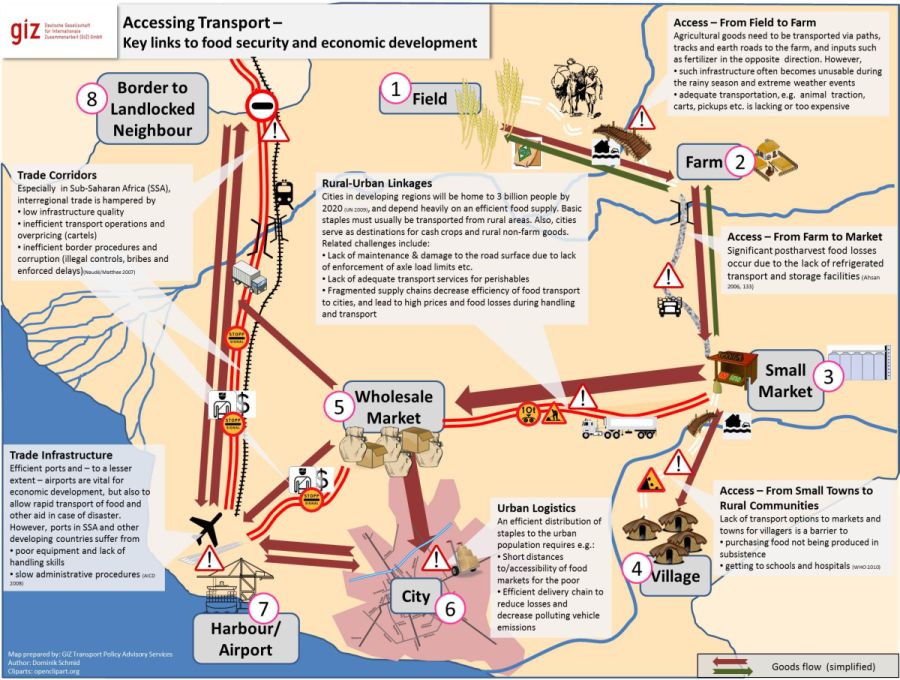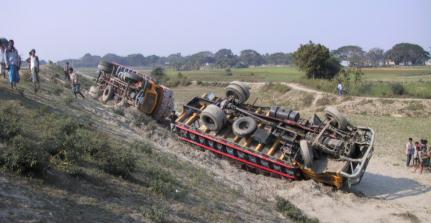Access to Transport
Overview
Social and economic development in rural areas depends on many aspects - the access to transport and transportation services is surely a very significant one. The following article focuses on the importance of transport for rural development regarding its consequences on trade, agricultural production and accessibility of the population. The negative impacts on the environment are also considered. In adition, the article explores approaches to international cooperation from the perspectives of rural development and the transport system
Mobility and Rural Development
Many factors drive economic and social development in rural areas. A factor that is invariably crucial is the access of people living in rural areas to transport infrastructure and services. Without transport, goods and services cannot be brought in sufficient quantity to the people who need them, agricultural products cannot be taken to market, children cannot attend school and those in need of medical attention cannot get to the nearest clinic. A diverse and vibrant exchange between rural areas and conurbations also depends on an effective transport system, as does participation in political and social life. Evaluating the part played by transport in rural development requires a broad perspective that does not merely focus on the rural road network and the accessibility of local markets and basic services but in addition considers the trans-regional links, including import and export corridors and hubs, that are also important for economic development.
The significance of transport will be explained more thouroughly within the following two articles:
- Access to Basic Services and Accessibility of the Population
- The Perspective of Agricultural production: Access to Inputs and Markets
Within the planning process an intensive cooperation between the sectors of transportation and rural development is required. The experience of numerous rural road-building projects has shown that, regrettably, close coordination between transport and rural development experts is rare. Transport promotion measures are not always integrated into the context of spatial or territorial development planning or social infrastructure. Integrated planning of investment in rural development also needs to give greater weight to the medium- and long-term challenges. In the case of infrastructure measures, it is particularly important to consider how maintenance is to be financed.In addition, the likely effects of climate change need to be taken into account in connection with both road building and maintenance.
The following picture gives an overview about the key links between access to transport and rural economic development and food security.
In the following, a few regional examples for a clearer view:
Access - From Farm to Market:
In India, at least 50% of the production of fruits and vegetables is lost due to wastage and value destruction, with lack of adequate transport being one among the multiple causes. Annual costs estimated at 5 billion US$ .(Ahsan 2006, 133)
Access - From Small Villages to Rural Towns:
More than 900m People worldwide lack access to all-weather roads. The risk of death during giving birth is 36times higher for women in developing countries, not least to the lack of access to medical treatment (WHO 2010)
Trade Infrastructure:
Average costs for container handling (ship-to-gate) in East Africa are US$135–275, compared to only US$80–154 in the rest of the world (AICD 2008)
Trade Corridors:
29 % of total transport costs for getting a truck load of onions from Madaoua, Niger to Accra, Ghana are caused by corruption (Bromley et al 2011)
Landlocked countries in Africa may lose the equivalent of up to 40% of the export on high transport costs (Naudé/Matthee 2007)[1]
The Environment and Safety: Adverse Effects of Transport Infrastructure
The Tanzanian government caused a furore when it announced its intention to drive a road through the unique Serengeti nature reserve. The planned east-west highway would divide the park into a northern and a southern half and the knock-on effects were cited as a particularly egregious example of the negative externalities of transport routes. The road could sever the routes taken by two million animals to their waterholes, with serious consequences for the ecological balance of the nature reserve (Bigurube, Borner, Sinclair).
Effects on the Environment
The construction of transport routes in rural areas opens up access to previously remote ecosystems and thereby facilitates the clearance of forests, much of which is carried out illegally. Studies show that around two-thirds of all forest clearance can be attributed to the construction of transport infrastructure. The accompanying problems include noise nuisance, air pollution and higher numbers of accidents.
In addition to facilitating illegal logging, the increased accessibility provided by transport routes and the accompanying reductions in transport times and costs also put indigenous peoples at risk, provide easier access for poachers and promote land speculation, the construction of illegal settlements and uncontrolled exploitation of minerals and natural resources (Geist, Lambin 2001).Illegal mining activities destroy farmland and create disorder in rural areas, disrupting both the physical and the social fabric of communities. In the southwest of Burkina Faso, for example, laboriously rehabilitated farmland is being ruined again by unregulated gold mining. In this context it is also worth pointing out that the construction of transport routes can also change land-use conditions to the disadvantage of the resident rural population. For example, road building can provide momentum for negative impacts such as land grabbing or forced displacement of the resident population, perhaps to land that has not yet been made cultivatable. [2]
Spread of HIV
Transport projects that connect corridors or countries also help to accelerate the spread of disease. Particularly noticeable is the spread of HIV as the virus is exchanged between local people and lorry drivers or construction workers, who often spend a long time living away from their families. For some poor rural dwellers, prostitution with the relatively affluent lorry drivers is an important source of income that enables them to feed their families. According to a study conducted by the World Bank in South-East Asia, up to 80 per cent of long-distance lorry drivers regularly use the services of prostitutes (World Bank).
Accidents
Young and socially disadvantaged people have a higher than average risk of being involved in road accidents; where someone lives is also a key factor in their accident risk. Studies of the Bangalore area of India show the risk of being killed in a road accident is three to four times higher in rural areas than it is in urban districts. One reason for this is the tendency of drivers to over-estimate their skill and to drive excessively fast outside built-up areas. When an accident occurs in a rural area, medical assistance is often a long way away and is rarely up to the standard available in towns and cities. Accessing medical care or paying for a funeral as a consequence of a traffic accident often plunges entire families in developing countries into significant financial dependency (WHO 2009).
|
Road accidents are among the most serious impacts associated with increased traffic volumes: an accident involving two lorries in Bangladesh.[3] |
Conclusions
The examples of negative external effects have demonstrated that these effects must be considered right from the start when transport projects are being planned. The relevant impact assessments are now standard in financial cooperation projects. Support measures should be offered, and the implementation process should include everyone affected or involved – the rural population, decision-makers at national and district level and local people. Specific roles, responsibilities and tasks can be assigned and stakeholders can be supported through training and advice. For example, young people can act as school crossing patrols, workers can be responsible for the distribution of information materials at payment points and lorry drivers can help pass on these materials. Local and national government offices have a part to play in planning and implementing measures that affect land use, compliance with legislation, transport planning, capacity development of village and community structures and the use of natural resources.
Further Information
Further information on Transport and Rural Development:
Transport Division (TD) & Asian Institute of Transport Development (2000): Impact of Rural Infrastructure Investment. – In: Evaluation of Infrastructural Interventions for Rural Poverty Alleviation. – pp. 29-44: http://www.unescap.org/ttdw/Publications/TPTS_pubs/pub_1959/rurpov_ch3.pdf
References
- ↑ Machbarkeitsstudie
- ↑ http://www.unescap.org/ttdw/MCT2006/Documents/English/MCT_SGO_7E.pdf
- ↑ Photo: Rainer Kuhnle, 2001





















